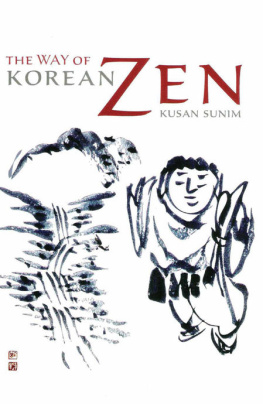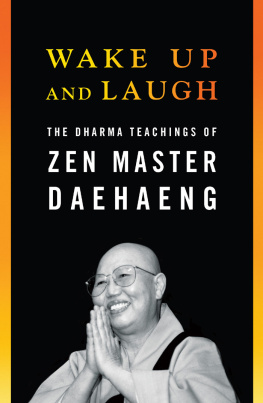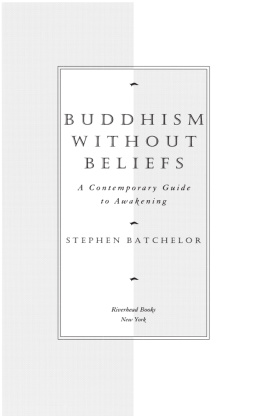I highly recommend this wonderful book which affords us a birds-eye view into the teachings of Korean Zen Master Kusan Sunim. The teachings are concise yet comprehensive. A welcome addition to the growing body of writing on Korean Zen.
Richard Shrobe (Zen Master Wu Kwang), Guiding Teacher, Chogye International Zen Center of New York
A modern Zen classic with deep roots in the oldest traditions of Korean and Chinese Buddhism. Kusan roars like a lion.
Stanley Lombardo
ABOUT THE BOOK
The power and simplicity of the Korean Zen tradition shine in this collection of teachings by a renowned modern master, translated by Martine Batchelor. Kusan Sunim provides a wealth of practical advice for students, particularly with regard to the uniquely Korean practice of hwadu, or sitting with questioning. An extensive introduction by Stephen Batchelor, author of Buddhism without Beliefs, provides both a biography of the author and a brief history of Korean Zen.
KUSAN SUNIM (19011983) was the resident Zen Master at Songgwang Sa, one of the largest monasteries in South Korea. He was the first Zen teacher to accept and train Western students in a Korean monastery.
Sign up to learn more about our books and receive special offers from Shambhala Publications.

Or visit us online to sign up at shambhala.com/eshambhala.
THE WAY OF
KOREAN ZEN
by Kusan Sunim
translated by Martine Batchelor
edited with an introduction
by Stephen Batchelor
WEATHERHILL Boston & London 2013
Weatherhill
An imprint of Shambhala Publications, Inc.
Horticultural Hall
300 Massachusetts Avenue
Boston, Massachusetts 02115
www.shambhala.com
1985 by Songgwang Sa Monastery
Cover art by Sokchong Sunim
All rights reserved. No part of this book may be reproduced in any form or by any means, electronic or mechanical, including photocopying, recording, or by any information storage and retrieval system, without permission in writing from the publisher.
Distributed in the United States by Random House, Inc., and in Canada by Random House of Canada Ltd
Reproduced in Chapter Eight are Zen paintings by Sokchong Sunim, a contemporary Korean Zen artist, that were especially commissioned for this work.
The frontispiece calligraphy, the characters for one mind, is by Master Kusan.
The Library of Congress catalogues the previous edition of this book as follows:
Kusan Snsa.
The way of Korean Zen.
Translated from the Korean.
eISBN 978-0-8348-2693-9
ISBN 978-0-8348-0201-8
ISBN 978-1-59030-686-4 (pbk.: alk. paper)
. Zen BuddhismKorea.
I. Batchelor, Stephen. II. Title.
BQ 9262.9.K7K87 1985 294.3'927'09519
8425602
Deep in the valley of Mount Chogye a giant boulder shouts;
The lions brain is shatteredthe elephant has expired.
The vessel was huge and vast, his instruction steep and rigorous;
The teachings enveloped the world and his dignity stirred the oceans.
The mind-mirror is so limpid and bright;
Guest and host are both destroyed.
The brilliant shining is unobstructed;
All forms are vividly clear.
You opened your hand and space collapsed;
You clenched your fist and flowers bloomed on withered trees.
Ha! Ha! Ha!
With the mind of a snake, the mouth of a Buddha, and the eyes of a ghost,
You majestically step into Avci.
Songchol Sunim, Patriarch of the Chogye Order, on the occasion of Kusan Sunims death, December 1983.
Contents
Publishers Note
This book contains Sanskrit diacritics and special characters. If you encounter difficulty displaying these characters, please set your e-reader device to publisher defaults (if available) or to an alternate font.
T HE AIM of this book is to present the teachings of Zen Buddhism as they are traditionally taught in Korea today. To help place these teachings in their proper context, an introduction is included that tries to give a picture of their historical background and current monastic setting. The author, Ven. Kusan Sunim, was one of the most highly respected meditation masters of recent times in Korea.
During the last two years of his life, Master Kusan took an active interest in the preparation of this text. He willingly clarified many of the more difficult points in his teaching; provided us with relevant biographical material; and prepared several examples of his calligraphy to be used as illustrations for the book. He personally approved the first draft of the manuscript when it was presented to him at the end of 1982. The only substantial change made since then has been the inclusion of his commentary on the ten oxherding pictures, a tape recording of which was made available to us only after his death.
Since this book is intended for the general reader we have taken the liberty of omitting all the diacritical marks that, for scholarly accuracy, are usually found on certain Korean, Sanskrit, and Japanese words. Nevertheless, these marks have been retained in the glossary. We have followed the McCune-Reischauer system for transliterating Korean words into English. Chinese words are given in Pinyin romanization, with Wade-Giles equivalents given in the glossary. Since the Japanese word Zen is now part of the English language, we have used it throughout instead of the Korean Son.
We would like to acknowledge the help of the following people in contributing to the completion of this work: Ven. Popchong Sunim, who clarified a number of technically difficult passages and traced many of the sources and references; Ven. Sokchong Sunim, who supplied the illustrations for the ten oxherding pictures; Ven. Wondu Sunim (Michael Roehm), who proofread the text and assisted in the initial stages of bringing the book to the public; Robert Buswell, who provided us with a typescript copy of the introduction to his book The Korean Approach to Zen: The Collected Works of Chinul and offered many valuable suggestions for the improvement of the original draft; and Henrik H. Srensen, who initially suggested the idea of undertaking this project.
Martine (Fages) Batchelor
Stephen Batchelor
Songgwang Sa,
Korea, 1984
CHAPTER ONE
T HE COUNTRY of Korea is formed of a peninsula of land jutting out into the East China Sea from the northeast coast of China below Manchuria. Its southeastern tip nearly connects to the arc of islands sweeping northwards known as Japan. Geographically it almost looks like a bridge between its two larger and more powerful neighbors. And throughout its history it has been frequently subjected to threats of invasion and domination by both China and Mongolia from the passes of the north and by Japan from across the sea. Armies from the feuding states in China have penetrated into its heartland and the Japanese have periodically tried to secure the country as a foothold on the Chinese mainland. More recently Korea has served as a battleground between Communist and non-Communist forces fighting to control the country.
Hence this small, rugged, and picturesque land, inhabited mainly by farmers and fishermen, has been and still is characterized as an area of disproportionate potential and actual political strife. This climate has given rise to a strong-willed and resilient people, one of whose principal drives is to create and sustain a sense of national unity and independence in the face of external pressures.
















